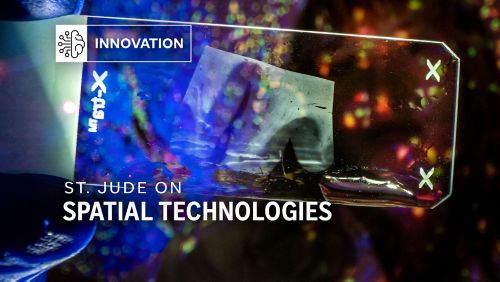St. Jude Family of Websites
Explore our cutting edge research, world-class patient care, career opportunities and more.
St. Jude Children's Research Hospital Home

- Fundraising
St. Jude Family of Websites
Explore our cutting edge research, world-class patient care, career opportunities and more.
St. Jude Children's Research Hospital Home

- Fundraising
Climbing the spatial omics ladder to biology’s unpicked fruit

Spatial omics brings tissue analysis to new levels at St. Jude Children’s Research Hospital, by offering unbridled access to the diversity of cells and their spatial organization within each sample.
In a Rio de Janeiro grocery store, 1 minute and 53 seconds was all Rosilda Ferreira needed to scan and bag 50 grocery items — a new world record. This feat, achieved in 2009, was the culmination of decades of innovation stemming back to 1974 when the first grocery item with a barcode was scanned (a packet of chewing gum). The commerce innovation revolution was based on two things: speed and numbers. The faster you can process an item, the faster you can work through customers.
A similar shift is taking place in cell biology. Tissue staining, which often uses hematoxylin and eosin (commonly referred to as HE staining), is a widely used method to examine the structure and arrangement of tissues (morphology). It’s often used to analyze biopsies and diagnose diseases such as cancer and is cheap, easy, and quick. But there are limitations.
Tissue staining can only detect two to five markers in cells at a time, meaning telling the difference between cells in complex tissue environments is limited. If Ferreira had to find and enter the individual price of each item before bagging, the world record for grocery checkout would be much longer.
However, a cell’s identity is written in the genes it expresses — its transcriptome. If transcriptomes could function like barcodes, thousands of cells could be rapidly analyzed at once. The cellular environment of a tissue would light up with the diversity that was always hidden beneath the surface of a stain. Researchers could point to exact cell populations resistant to therapies and target them individually.
The demand for biomedical researchers to understand cell diversity has grown beyond what stains can offer. To reach this unpicked fruit across biology, researchers needed to increase the speed and number at which cells within tissues can be scanned.
An innovation revolution was in order.
Barcoding technology kickstarts spatial revolution
This endeavor to understand individual cells at their molecular cores and place them in the context of their environment has unified the field of spatial omics. With rapid innovation driving this pursuit, Jasmine Plummer, PhD, Director of the St. Jude Center for Spatial Omics, has positioned herself within the hospital as the Rosilda Ferreira of cellular scanning.
“Spatial omics stems from something very old, which is tissue staining. The -omics part comes from harnessing what genomics has done for a long time and putting that onto tissue,” explained Plummer. “Staining can maybe look at five individual markers with every marker having a different color. Spatial omics takes all those markers and puts a barcode on them instead.”
The ability to image cells within their environment based on the genes they express began with the development of in-situ hybridization (ISH). The technology expanded to utilize fluorescently labeled DNA or RNA probes, which bind to complementary gene transcripts within cells (FISH). Perhaps the first clear sign of an innovation revolution was the introduction of multiplexing, i.e., using multiple rounds of probes to label cells. If a targeted gene transcript were in a cell, it would fluoresce. If it were absent, it would not. By numbering a fluorescent signal as “1” and the absence as “0”, researchers create a binary sequence for each cell based on their expressed genes.
Through multiple rounds of FISH-ing, scientists can reveal cell identity. In essence, this process became a transcriptome barcode. Cells that express the same genes have the same barcodes, putting each cell in context with its neighboring cells.
Adding a barcode system had the same effect on genomics as on commerce and then some. Barcodes boosted the rate at which samples can be processed and the number of different gene transcripts that can be examined within each sample. And as the technology around this innovation has grown, sample processing has hit overdrive.
“This time last year, we talked about multiplexing 1,000 genes by ISH. Now, we can do 6,000 genes. That has a lot to do with barcoding, including how labels are applied to generate barcodes, how to image it fast enough, stitch it fast enough and then go on to the next round,” said Plummer. “But also, microscopes can scan faster, and supercomputers are faster at data acquisition. The technology around all this has finally caught up.”
Parallel to advancements in imaging is a considerable amount of groundwork laid in gene sequencing technologies. Today, a person’s entire exome (the genome region that encodes proteins) can be sequenced 20,000 genes at a time, another byproduct of multiplexing and barcoding technology.
Plummer sees all these innovations as additive to her and the Center’s goals. “The spatial omics part is just pulling it all together so we have the most information, the same way we have for whole exome sequencing. Now, we can collect all this data immediately.”
Spatial omics removes the bias from information seeking
At St. Jude, the lure of such detailed information on tissue populations has garnered the attention of researchers and clinicians alike. And while spatial omics has benefited from innovation from a wide range of fields, these fields are now tapping back into the potential of spatial omics as an innovation in itself.
Wilson Clements, PhD, Department of Hematology, was compelled to explore the potential of spatial omics through innovative thinking by a postdoctoral researcher in his lab, Diana Sá da Bandeira, PhD. In a study published in Development, first author Sá da Bandeira and co-corresponding author Clements investigated hematopoietic stem cell development in mice.
They discovered the role of two genes, Nr4a1 and Nr4a2 (which code for gene-regulating proteins called nuclear receptors), in driving stem cells’ maturation early in embryo development. “In vertebrate embryos, hematopoietic stem cells arise in a region called the dorsal aorta at a particular time point in embryonic development,” Sá da Bandeira explained. “We found that when hematopoietic stem cells start being specified, without these two genes, they become arrested at a specific time in development and don’t undergo the whole maturation to become real hematopoietic stem cells.”
This information is vital to understand treatments for hematological diseases better. However, when preparing their findings for publication, they were challenged to expand on them further.
“One of the obvious questions we were asked was about the mechanism: why is this happening?” Sá da Bandeira said. “Initially, we tried other techniques but were hindered by the need for specific antibodies or probes. You get information on those genes but lose so much more. We could be looking at the wrong pathways or something with bias.” This led Sá da Bandeira to Plummer’s lab, where the innovation revolution in large-scale cell profiling was ramping up.
During hematopoietic stem cell maturation, a cell signaling pathway called Notch is vital for determining cell fate and tissue patterning. Once a cell’s fate is determined, Notch signaling is turned off. However, the spatial omics data revealed an unusual persistence in Notch signaling without the two genes. This allowed Clements to address the mechanism queries from a completely unbiased perspective.
“If you have a limited set of signaling pathways you’re asking questions about, you can only find what you are looking for. With this spatial omics approach, we could ask how the pathways change when hematopoiesis proceeds normally and when it’s arrested,” Clements said. “We now have a lot of opportunity for further investigation.”
Innovation does not come without some headaches. Assigning identities to cells that are still developing was a challenge for the researchers and required the design of entirely new probes. However, challenges like this do not exist in a vacuum, and Clements sees the long-term benefit of tackling it head-on.
“For diseased tissues, such as tumors, there’s also a lot of mixed cell types and transcriptional changes,” Clements explained. “Optimizing these approaches for hematopoietic stem cells and sorting out difficulties for cell identity assignment is a symbiotic relationship, which will also apply to pathological situations.”
A fledgling clinical technology with a world of potential
On the pathological front, Jason Chiang, MD, Department of Pathology, looks at spatial omics as a tool to better understand patient’s tumors. “The closest we had before this technology is immunohistochemistry or in-situ hybridization and then trying to guess what cells we were looking at,” Chiang explained. “But with spatial omics, we can expand this to the entire transcriptome with a spatial distribution. We can know exactly where genes are expressed in the tumor, and in what cell type, and what other genes and proteins are expressed in that cell type, in that location.”
Like the growth of hematopoietic stem cells in an embryo, the development of tumor cells is greatly influenced by their location within the tumor. Spatial omics offers pathologists, such as Chiang, the chance to understand tumors in their context within the body.
“The tumor does not exist just by itself. It has to be supported by the surrounding tissue. But what is the relationship of all those cells? Are they, in fact, supporting the tumor cells, or are they inhibiting them?” Chiang said. “If they are supporting, that’s what we need to gear our therapy against, and if they are against the tumor, we want to support those activities.”
While the tried-and-tested staining methods are still the gold standard for pathology, Chiang hopes that in the not-too-distant future, the academic power of spatial omics can meet the rapid demand in the clinical world. Ongoing work seeks to do just that. “On the research front, we analyze tumors in different ways, including by spatial omics, and we are always learning from these tumors,” Chiang said. “While spatial is not officially clinical yet, we are beginning to bridge the gap toward how we envision it will be used for patient care.”
Bridging the gaps between discovery and application
As innovations in multiplexing, barcoding and data processing allow the field to grow, further innovation relies on researchers such as Clements and pathologists such as Chiang to buy in and test spatial omics as an innovation to their respective disciplines.
“I do genetics and single-cell analysis in my lab, so I followed genomics into spatial omics to see where my single-cell data spatially lies,” Plummer said. “But researchers that already look at individual genes in this context with tissue and mouse models are also beginning to enter spatial omics with their knowledge base because they are no longer tied to seeing just three or four markers, but hundreds. Now they can classify many more cell types.”
As she continues expanding the cellular scanning capabilities of the Center for Spatial Omics at St. Jude, Plummer keeps one eye on emerging innovations. Barcodes were revolutionary in accelerating commerce, and they are having the same effect on cell biology. Now, machine-learning processes are poised to turn many industries, including biomedical research, on their heads.
“Every spatial experiment we do is at least 100 thousand to 5 million cells on one slide, so the more tissues you test, regardless of the tissue, you eventually don’t even need a cell assignment marker anymore,” she explained. “Over time, the technology will develop to learn what is or is not a cell, and what type of cell it is.”
The potential to understand cells in the context of their environment is fueling an innovation revolution that is still in progress. But one thing is certain: As more datasets are presented and the technology expands further, more and more researchers and clinicians will turn to spatial omics as a ladder to reach the unpicked fruit of their own investigative journeys.






